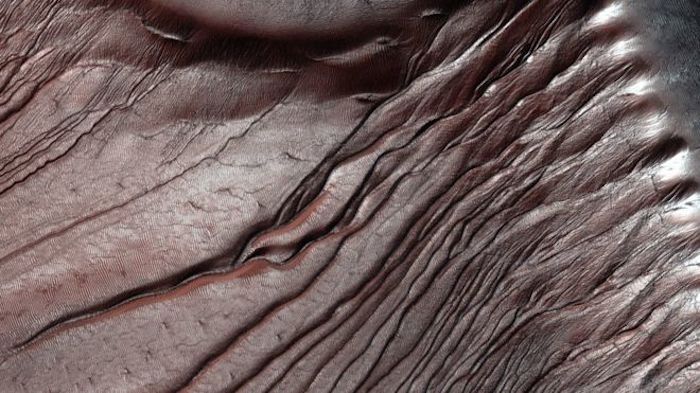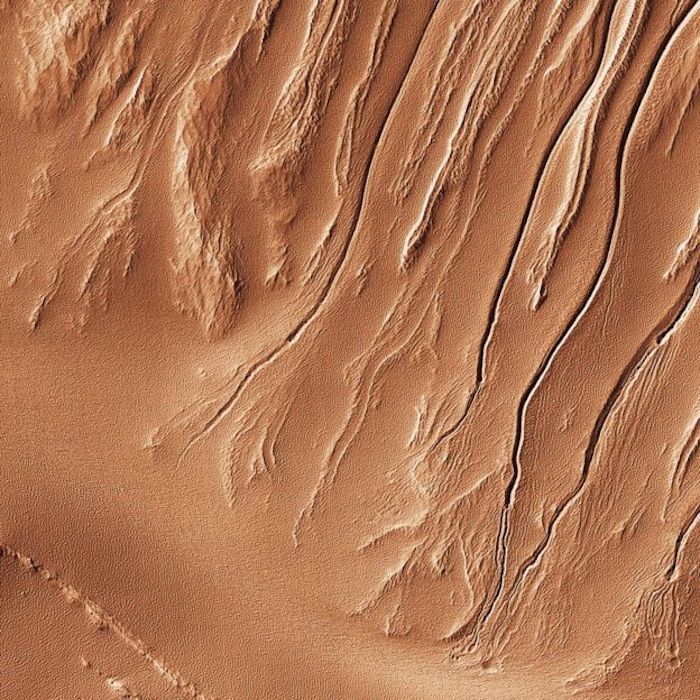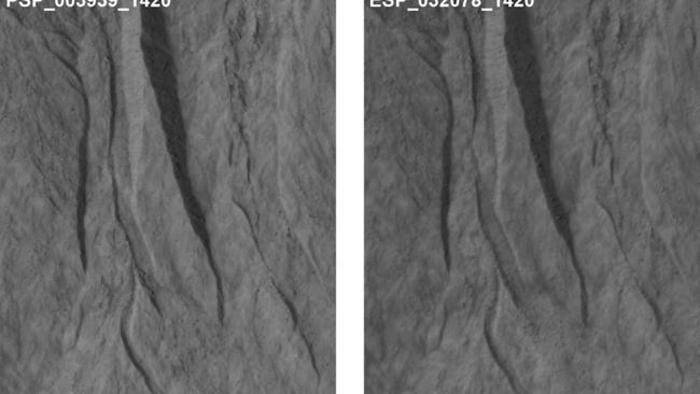.

Trapped CO2 gas may form Martian gullies
.
The study looked at gullies like these in Russell Crater, shown with winter CO2 frost accumulating
Gullies seen on the surface of Mars could be formed by trapped CO2 gas causing sand to flow downhill, a new modelling study suggests.
In the Martian winter, a layer of CO2 frost - dry ice - forms on the surface in many regions of the red planet.
Writing in Nature Geoscience, French researchers now suggest that as it defrosts, this icy layer traps gaseous CO2, causing a build-up of pressure.
They say this gas, rather than liquid water, can explain the Martian gullies.
These small valleys, cut into hillsides and dunes in many areas near the planet's equator, had been something of a puzzle.
Some researchers had suggested they were evidence for a wet period in Mars's ancient past, but many of the formations are relatively young, in geological terms, and others are still forming today.
This means something other than water must be responsible, because the surface of Mars in these locations is far too cold to support liquid water.
Sublime and slide
Proposed explanations have stretched as far as "ice hovercraft" - blocks of solid CO2 tobogganing down the dunes.
But Cedric Pilorget and Francois Forget, from Université Paris-Sud and Sorbonne Universités respectively, have a new idea.
As the CO2 frost starts to sublime into gas at the end of winter, they suggest, some of that gas can be trapped under as much as 30cm of dry ice.
They modelled how this process might unfold on a huge dune in the Russell crater, where brand new gullies have been glimpsed by Nasa satellites.
That build-up of pressure, Drs Pilorget and Forget found, can produce a "gas-lubricated debris flow" that cascades down the slope, leaving a gully in its wake.
"Such processes may involve large amounts of material and do not require any liquid water," they write.
.

The gullies have been studied in great detail thanks to satellite images like this one, from Newton Crater
This is important, because the gullies concerned can be tens of metres wide - unlike the smaller "recurring slope lineae" which scientists proposed in September might be caused by small amounts of very salty water.
Furthermore, the team's modelling work predicts that the best conditions for these gas-powered landslides occur in the very same places where these gullies have been observed.
In a comment article for Nature Geoscience, Colin Dundas from the US Geological Survey said the French team's model was "a good match to many observations of gully activity", but added that there are probably multiple processes at work.
"The story emerging over the past decade of monitoring the Martian surface is that Mars, like Earth, is a dynamic world with many active processes," Dr Dundas writes.
"It would be surprising if only a single process was involved in gully formation."
Quelle: BBC
---
Dry ice, not water, responsible for many gullies on Mars, study says

This pair of images shows one of hundreds of Martian sites where researchers have used NASA's Mars Reconnaissance Orbiter to study changes in gullies on slopes. (NASA/JPL-Caltech/Univ. of Arizona)
.
Gullies on Mars that appeared to have possibly been carved by water were probably dug out by great chunks of dry ice, a pair of French researchers say.
Even as certain lines of evidence mount for the very occasional occurrence of water on present-day Mars, the findings published by the journal Nature Geoscience serve as a reminder that not every familiar-looking geological feature on Mars has an analogue on Earth.
“When dealing with other worlds, we must take care to remember that unfamiliar processes are possible and even likely in alien environments,” Colin Dundas of the U.S. Geological Survey’s Astrogeology Science Center, who was not involved in the research, wrote in a commentary on the work.
As NASA orbiters and rovers probe the Red Planet from above and on the ground, there’s been growing support for the idea that water was once plentiful on our dry, dusty neighbor. The Mars Science Laboratory rover, known affectionately as Curiosity, has found signs of a long-lasting series of lakes that rose and fell in Gale Crater over many millions of years. Analyses of pebbles in the crater have revealed hints of a sustained river as well. Other papers have posited the idea that Mars was once had a large ocean that slowly disappeared over the eons.
All of this was a Mars in the distant past. But even today, researchers are beginning to think there could be some liquid water – albeit very harsh, salty water – that on very rare occasions briefly exists on the surface today. The recent discovery that dark streaks known as ‘recurring slope lineae’ could have been left by contemporary liquid water compelled NASA officials to wax enthusiastic about the planet’s current habitability.
“It suggests that it would be possible for there to be life today on Mars,” John Grunsfeld, associate administrator of NASA's Science Mission Directorate in Washington, said at a briefing announcing those results (also published in Nature Geoscience).
Not all streaks on slopes are potential signs of a wet present; far from it, in fact. A pair of French researchers has analyzed different features — Martian gullies in the planet’s mid-latitudes, deep channels that on Earth would have looked like they were carved by streams or sliding wet debris. But the proposed explanations would require groundwater discharge, which would be unlikely in the spots where many of these gullies are found, on lone peaks and sand dunes.
“Martian gullies have attracted considerable attention because they resemble terrestrial debris flows formed by the action of liquid water,” lead author Cedric Pilorget, a planetary scientist at the Institut d’Astrophysique Spatiale in France, wrote in an email. “This has been puzzling because such features are geologically recent (less than a few million years old) and have thus formed during the current cold and dry Martian era. Was water involved, to what extent and what could it mean in terms of habitability?”
Instead, the researchers pointed to another possible cause: frozen carbon dioxide. Carbon dioxide is the by far the most abundant gas in the Red Planet’s atmosphere, and much of it sticks to the surface in winter, stretching from meter-thick ice caps near the poles to surface frost in the mid-latitudes.
And, as it just so happens, “the distribution of frost correlates with the regions where gullies are most prominent,” Dundas wrote. “Moreover, gully activity appears to be seasonal, with a marked preference for the winter and spring — when CO2 frost is observed on mid-latitude slopes.”
Scientists have had an idea that frozen carbon dioxide (also known as dry ice) could have been the cause of such gullies for a while now, but they weren’t sure how it worked, said Alfred McEwen, a planetary scientist at the University of Arizona and leader of the HiRISE camera on NASA's Mars Reconnaissance Orbiter, which has taken images tracking the development of current gullies on Martian slopes.
"This activity did not involve liquid water; we’ve known that for some time," McEwen said. "But how do you explain the gullies exactly, especially since they look so much like water-carved gullies?"
In the new paper, the scientists studied the frost on slopes at different locations and in different orientations with respect to the sun, developed models to analyze how carbon dioxide would act at different temperatures, and presented a mechanism that could explain the gullies’ creation.
Since dry ice can freeze into a thick translucent slab, sunlight can travel all the way to the ground and cause the dry ice to start to sublimate – go from a solid directly to a gas – at the slab’s base.
“This causes pressure to rise beneath the ice slab, and eventually causes the slab to lift and break apart, rapidly expelling both gas and entrained regolith material,” Dundas said.
The model also seems to fit with the Red Planet’s behavior over time. Within the last million years, Mars had a much greater tilt, of 35 degrees instead of the current 25 degrees. A more pronounced tilt, or obliquity, would actually help better explain the locations of many of the planet's fresher-looking features.
There are a few gullies closer to the equator that can’t be explained by dry ice frost, Dundas pointed out – though that doesn’t rule out the dry ice frost for the other locations. It simply might mean that there are multiple processes happening on Mars, depending on the locale. Liquid water, or water ice, could also play a role.
“The story emerging over the past decade of monitoring of the Martian surface is that Mars, like Earth, is a dynamic world with many active processes,” Dundas pointed out.
Quelle: Los Angeles Times
4124 Views
